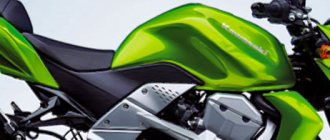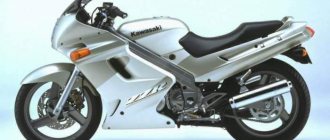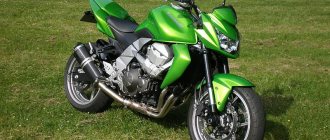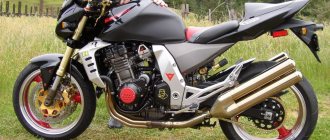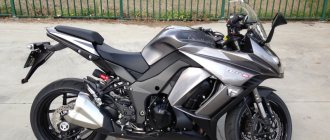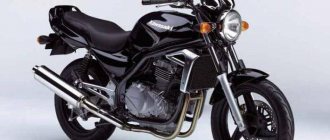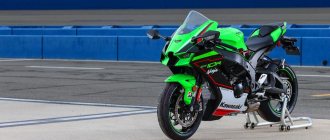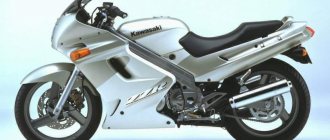RU-MOTO rating
- Reliability
- Chassis
- Appearance
- Comfort
3.8
Verdict
The best choice for those who want to purchase a reliable means of transportation around the city and to the country. The tourism component prevails over the sports component. But, at the same time, you can drive with the breeze.
The Kawasaki ZZR 400 was one of the first sport-touring motorcycles. Its feature was an aerodynamic plastic body kit. Produced from 1989 to 2006. During this time, it has not undergone any major changes, apart from a minor update of the exterior.
Since 1992, equipped with a wider 160 mm tire instead of 140 mm. In 1993, mass production of the modified ZZR 400–2 model began. The Zizer was shortened by 1 cm. In 1997, the instrument panel changed.
000_moto_0211_040
Kawasaki ZZ-R400: sports tourer, 1990–1997, 398 cm³, 53 hp, 197 kg, 80,000–180,000 rub.
Kawasaki ZZ-R400: sports tourer, 1990–1997, 398 cm³, 53 hp, 197 kg, 80,000–180,000 rub.
STORY. Sales of the Kawasaki ZZ-R400 motorcycle started in 1990, and in the company’s model range it replaced the obsolete GPZ400R, which had been produced since 1985.
The sports touring motorcycle was created for the Japanese domestic market, as an analogue of the “six hundred cc” version for Europe. From this followed the main advantage of the “Zizer” over all its “classmates”: full size. Other “four hundred” cars were developed from scratch specifically for short Japanese people, and the ZZ-R400 differed from its “European” brother only in its reduced engine capacity. The suspension, fairings, controls and frame were taken from the 600. Hence the incredible popularity of the device on the second-hand market in Russia. Not a single one offered “so much motorcycle” for quite modest money. The motorcycle remained in production for 16 years, almost unchanged, and since 2010 its place on the domestic market was taken by the Ninja 400R, a four-hundred-cc analogue of the well-known ER6-f.
Main competitors
- The Suzuki RF 400, produced from 1993 to 2000, is one of the most common competitors of the Zizer. These two models are almost identical in specifications, and both have their pros and cons. However, the ZZR 400 is much more common, which can undoubtedly be considered one of its advantages. If the RF 400 needs repairs, you are unlikely to find spare parts in stock.
- Honda VFR 400, in different versions and under different names (RVF 400) produced from 1986 to 2001. The first generation of this motorcycle can boast of terrifying acceleration dynamics, which sets it apart from other 400 cc sports tourers. However, due to its advanced age, finding such a copy in good condition is quite problematic, and the latest generation, produced since 1994, is comparable to the ZZR 400 in all respects.
004_moto_0211_040
2010 (Ninja 400R).
2010 (Ninja 400R).
Upgrade table
| Years of manufacture | Major design changes |
| 1990 | Model debut (ZZ-R400K). Engine power: 58 hp at 12,000 rpm, 36 Nm at 10,000 rpm. Dry weight 195 kg. |
| 1993 | Modification ZZ-R400N (better known as ZZ-R400-II). Power reduced to 53 hp. at 11,000 rpm, torque - 37 Nm at 9,000 rpm. The wheelbase has been reduced by 10 mm (to 1430 mm), dry weight has increased by 2 kg (to 197 kg). Inertial charging appeared, the shape of the “plastic” was changed, and a fuel gauge appeared on the dashboard. |
| 1997 | Instead of a second daily odometer, there is an electronic clock in the tachometer housing. Rear shock absorber with adjustable spring preload and rebound force. |
| 2001 | An exhaust gas afterburning system (KLEEN) appears in the exhaust system. |
FOR WHAT? “Zizer” is a sports touring motorcycle designed specifically for beginner Japanese motorcyclists.
Its character is soft and flexible, but unlike its competitors, the ZZ-R is a “big” motorcycle. It was this fact that brought the “Zizer” to the top of popularity in Russia, because prices for the ZZ-R400 on the secondary market were slightly higher than for “naked” classics like the Honda CB400 Super Four or Suzuki Bandit 400, but the ZZ-R offered quite “ human" comfort behind the wheel, and it looked like a real sportbike. In this regard, Zizer simply had no competitors in its price category. The motorcycle, the design of which was developed in the late 80s, turned out to be so successful that even now it does not look like a complete anachronism. Probably, partly for this reason, the ZZ-R400 does not lose its popularity. Perhaps the main mistake (and a very serious one) of beginners, and they are the main “consumers” of the ZZ-R, is that they perceive the motorcycle as a “plastic rocket” - a real sportbike, which the “Zizer” is not. It is precisely this attitude towards a motorcycle and riding “for all the money” that leads to sad consequences and the spread of the opinion “zizer” is trash,” which is actually unfair.
General description of the motorcycle
Today, the Kawasaki ZZR 400 motorcycle seems somewhat ordinary and traditional.
But at the time of its creation, such a model was simply amazing.
And this is not only in terms of the design of the vehicle, but also its technical parameters, which were also excellent.
The motorcycle has a powerful sports bike frame made of aluminum alloy, as well as a four-cylinder engine with a liquid cooling system.
The perfect complement to everything else is a massive rear swingarm, disc brakes, a huge fuel tank, as well as a unique design, which until now is considered modern and impressive.
007_moto_0211_040
The brakes on the ZZ-R400 were carried over from the 600, so their efficiency is in perfect order.
The brakes on the ZZ-R400 were carried over from the 600, so their efficiency is in perfect order.
WHERE AND HOW TO SEARCH? In general, the design of the motorcycle is very reliable. There are no serious “diseases” in any components of the motorcycle, and all the problems that are often discussed when discussing the model are associated with inept operation of the motorcycle or misuse. The first and main advice when choosing a Zizer: look for a motorcycle “without mileage in the Russian Federation.” (takeaway) In the vast majority of cases, the ZZ-R400 is bought by compatriots as the first Japanese motorcycle, respectively, either after experience in operating domestic equipment, or without experience at all. As a rule, beginners have little knowledge in the field of proper maintenance and insufficient operating experience. And it is in the process of “learning” that motorcycles are “killed” literally within a season or two of living in Russia. The chance of finding a device in decent condition from those that have been with us for at least a couple of seasons is quite difficult. However, we should not forget that a device freshly imported from Japan can turn out to be a well-made-up “dead man,” although there are still not many of them.
When choosing a ZZ-R, you should not focus on devices from the first years of production. Even with the most careful operation, the gearbox resource is exhausted by 50–60 thousand km, and the engine becomes noticeably “tired” by this mileage. Motorcycles produced in the early to mid-90s (either in showrooms or through private advertisements) traditionally show no more than 25 thousand km on odometers - “a fresh addition, but hard to believe.”
Prices
A few years ago, more advanced models replaced the Kawasaki ZZR 400 on the assembly line . Prices for a new motorcycle, if it were produced today, would reach half a million rubles. For 150 – 180 thousand you can find a vehicle in excellent condition after one owner. The price range is quite significant. The cost depends on the model year, mileage and technical condition of the Kawasaki ZZR 400. Prices for used ones of different years of manufacture are as follows:
Prices for ZZR 400 of different model years. Screenshot from the portal moto.auto.ru
011_moto_0211_040
The speedometer “up to 260” indicates that the device is “not original”.
The speedometer “up to 260” indicates that the device is “not original”.
So, the device from 2000–2004, just imported from Japan, can be considered optimal in terms of price-quality ratio. It will cost an average of 130–170 thousand rubles. There is no point in buying newer devices from an economic point of view: for 200 thousand rubles. you can choose a much more cubic capacity apparatus.
Considering that, as a rule, “four hundred” cars do not stay in the same hands for more than a couple of seasons, we can safely talk about the high liquidity of this type of equipment. There is always a demand for entry-level motorcycles among the “younger generation”, and regardless of the condition of the motorcycle, it will be easy to sell it, although the amount that can be earned for a “running” device will directly depend on its condition. If during a year or two of operation the ZZ-R rarely encountered asphalt, did not participate in “street racing” and was well maintained, it will lose no more than 15–20% in price. When selling, however, it is worth considering that in recent years, entry-level equipment has shown a noticeable tendency to outflow to the regions. So, perhaps, it will be much easier to sell the “zizer” if you place advertisements in regional information resources on an equal basis with the central ones.
WHAT TO WATCH?
(-) A “crunchy” second gear while driving or a “jumping out” second gear is not a “family disease”, but a consequence of an overly zealous driving style in a vehicle that is calm in nature and purpose. Second gear is the heaviest gear on any motorcycle, as the difference between the gear ratios of first and second is greater than between any other adjacent gears, and the first-second pair is used most often, especially in urban traffic. Due to the difference in gear ratios and, as a consequence, the difference in the rotation speeds of the primary and secondary shafts, the second one is engaged with a noticeable shock load on the fork, the drive shaft and the gears themselves, which is why it becomes unusable after 40–50 thousand kilometers. All motorcycles are susceptible to this “disease”, especially “400” ones; it’s just that in the “Zizer” the unit itself has a slightly smaller margin of safety, which is why it fails faster than, for example, in a Honda.
The malfunction is diagnosed either on the move or while standing still - while holding the brake on the motorcycle, you need to engage second gear and smoothly release the clutch. If the motorcycle stalls, most likely everything is in order with the gearbox, otherwise the gear will simply “jump” into neutral. Overhauling the gearbox along with spare parts will cost approximately 25–30 thousand rubles, and, in addition, is a signal that the motorcycle is “tired” and other components. In short, if you suspect a gearbox malfunction, you should refuse to purchase this copy.
(-) It is worth paying attention to the engine oil level , especially if the motorcycle is bought second-hand. Even short driving with insufficient oil level can “kill” the crankshaft. By the way, the general increased noise of the engine itself indicates that, most likely, it was not “fed” with the best oil, did not monitor its level and was not changed in a timely manner. So it’s better to refuse a “clattering” motorcycle, even if the plastic is in perfect condition and the engine runs smoothly. What “surprise” the motorcycle will present after purchase is unknown.
(-) The tight movement of the clutch lever indicates that the release cam located on the shaft shank has worn out. The part itself is inexpensive (see Parts Table), but you need to remember that to replace it you need to remove the engine cover, so you will have to order a new cover gasket with the new shaft.
(-) Unstable engine idle can be caused by several reasons. Overheating often warps the plastic of the air filter housing, most often on the right side, and a gap forms in it through which unpurified air enters the engine. As a result, there is a violation of mixture formation and rapid contamination of carburetors. To detect this defect, just look into the gap between the gas tank and the diagonal of the frame. If there is a gap in the airbox, it will most likely be visible. The malfunction can be easily fixed using sealant or even regular tape. Also, the “fistula” may be located at the joints of the airbox and the air ducts leading to the carburetors.
Motorcycle design
The main distinguishing feature of the Kawasaki ZZR 400 motorcycle was that this model from its very creation was intended for domestic use in Japan.
Although, due to its width, the “zizer” will be an excellent option for tall people who will “saddle” this two-wheeled “horse”. The model's safety margin is significant .
After all, its frame and chassis are capable of withstanding heavy loads, which can be applied to a six hundred cc engine.
Since its design, this motorcycle model has hardly changed. After all, its production continues successfully to this day.
Only the colors of the bike and the shape of the deflectors on the sides have changed . And in 1993, they decided to make the base a little shorter, naturally reducing the power to 53 horsepower.
The reason for this was the introduction of power restrictions, which, willy-nilly, affected the entire range of motorcycles with an engine capacity of 400 cubic centimeters.
009_moto_0211_040
The same problem can occur in the first generation.
But here the airbox itself is visible to the naked eye, which can also “leak” along the seams. The same problem can occur in the first generation. But here the airbox itself is visible to the naked eye, which can also “leak” along the seams.
(-) Another possible cause of “floating” idle is a malfunction of the relay regulator. Low voltage confuses the ignition control unit. True, this “jamb” may not come out immediately, but after the battery runs out without proper charging (usually after half an hour or an hour of engine operation, and this is immediately visible from the dim light of the headlight). The relay itself, as a rule, “gives up” when using a faulty battery. The operation of the charging system is checked simply: at engine speeds above 4000, the voltage at the battery terminals must be at least 14.5 V.
Modernization and tuning
Most often, tuning a motorcycle consists of increasing the power of the unit. This is achieved by installing a more efficient Mikuni carburetor block. As for the appearance, there is also a custom-made plastic body kit.
Tuning examples:
Appearance tuning
White Zizer. Motorcycle styling
012_moto_0211_040
(+) Having sliders on a motorcycle is not just desirable, but vital. When a motorcycle falls, it is not only the plastic that suffers (even used ones are not cheap at all), but also the engine covers, which for this reason are in serious short supply even at large engine dismantling sites.
WHAT TO FOLLOW? The main thing is not to forget that the Zizer is not a sportbike. Do not try to set speed and acceleration records with it. The key to a long life of the engine and gearbox is smoothness and softness. A rather heavy machine with a phlegmatic engine is indeed not as playful as similar motorcycles from other companies, but the Zizer’s purpose is completely different than, for example, the no less popular Honda CB400SF. The ZZ-R is a car for traveling, that is, for smooth and uniform movement over long distances, and not a city “bullet gun”. You need to remember this constantly.
It is best to fill the engine with high-quality “synthetics”, monitor its level and change it at least once every 7-8 thousand kilometers. The model is not oil-guzzling, but a new device may well “eat up” the lubricant, and the sensitivity of the engine to its quantity has already been mentioned above.
WHAT TO BUY? If your motorcycle is not equipped with sliders, you should install them as soon as possible. The protection of the motorcycle in case of falls is very low. This is perhaps the only important recommendation. Otherwise, the depth and focus of tuning is determined only by the tastes and thickness of the owner’s wallet. Since the ZZ-R400 is completely similar to the 600 cc “European” in terms of dimensions and seats, you can find a lot of tuning for it, ranging from pannier systems and touring glasses to “gel” seats and other baubles of varying degrees of usefulness.
Estimated cost of spare parts for Kawasaki ZZ-R400
| Name | Original spare parts, rub. | Non-original spare parts, rub. |
| Repair kit for 2nd gear (gear, track shaft, fork, pan gasket) | 11500 | — |
| Clutch release shaft | 1500 | 1000 (used) |
| Voltage regulator relay | 6800 | 2000 (Chinese noname) |
| Front plastic (muzzle) | 26500 | 6000 (used) |
| Engine cover left. + gasket | 3900 | 1800 |
| Engine cover right + gasket | 6300 | 4000 |
| Sliders | — | 2600 (Crazy Iron) |
Spare parts, mostly available in stock.
Spare parts are sometimes in stock.
Spare parts, mainly imported to order.
COMPETITORS.
Advantages and disadvantages
The owners include a spectacular appearance as an advantage of a two-wheeled car. With proper care and maintenance, sufficient reliability is ensured. The cost of owning a motorcycle is low. At the same time, the requirements for service and driving style are strict. When actively using the clutch, second gear slips out. After reaching 120 km/h, acceleration dynamics decrease and become very sluggish.
pros
- Great bike for beginners.
- Very friendly, unpretentious in service.
- Reliable.
Minuses
- A bit heavy.
- Not very maneuverable.
- Sluggish acceleration after 120 km/h.
Specifications
Technical characteristics of Kawasaki ZXR 400:
| Model | Kawasaki ZXR400 |
| Motorcycle type | sports |
| Year of issue | 1989-1999 |
| Frame | aluminum diagonal |
| engine's type | 4-cylinder, 4-stroke, in-line |
| Working volume | 398 cm³ |
| Bore/Stroke | 57.0 x 39.0 mm |
| Compression ratio | 12.1:1 |
| Cooling | liquid |
| Number of valves per cylinder | DOHC, 4 valves per cylinder |
| Fuel supply system | Carburetor, 4x Keihin CVKD32 – ZX400H, ZX400L Carburetor, 4x Keihin CVKD30 – ZX400L3-L9 (Japanese versions) Carburetor, 4x Keihin FVKD32 (flat throttle) – ZX400J, ZX400M |
| Ignition type | transistor |
| Maximum power | 62.0 hp (45.6 kW) at 12500 rpm - ZX400H, ZX400J with inertial charging 59.0 hp (43.0 kW) at 12000 rpm - without inertial boost 65.0 hp (47.8 kW) at 13,000 rpm - ZX400L, ZX400M with inertial charging 53.0 hp (39.0 kW) at 12000 rpm – ZX400L3-L9 (Japanese versions) |
| Maximum torque | 39.2 Nm (4.0 kg*m) at 10,000 rpm – ZX400H, ZX400J 36.3 Nm (3.7 kg*m) at 12,000 rpm – ZX400L, ZX400M |
| Clutch | Multi-disc in oil bath, cable drive |
| Transmission | 6-speed |
| type of drive | chain |
| Front tire size | 120/60 R17 55H |
| Rear tire size | 160/60 R17 69H |
| Front brakes | 2 discs, 300 mm, 4-piston calipers – ZX400H, ZX400J 2 discs, 310 mm, 4-piston calipers – ZX400L, ZX400M |
| Rear brakes | 1 disc, 220 mm, 2-piston caliper |
| Front suspension | Inverted fork (adjustable), travel – 120 mm – ZXR400 Inverted fork (all adjustments), travel – 120 mm – ZXR400R |
| Rear suspension | Uni-Trak pendulum with monoshock absorber (adjustable), travel – 140 mm – ZX400H, ZX400J Uni-Trak pendulum with monoshock absorber (adjustable), travel – 120 mm – ZX400L, ZX400M |
| Motorcycle length | 2035 mm – ZX400H 2025 mm – ZX400J 1995 mm – ZX400L, ZX400M |
| Motorcycle width | 705 mm – ZX400H, ZX400J 710 mm – ZX400L, ZX400M |
| Motorcycle height | 1125 mm – ZX400H, ZX400J 1080 mm – ZX400L, ZX400M |
| Wheelbase | 1395 mm – ZX400H, ZX400J 1385 mm – ZX400L, ZX400M |
| Seat height | 765 mm – ZX400H, ZX400J 760 mm – ZX400L, ZX400M |
| Minimum ground clearance | 120 mm – ZX400H, ZX400J 115 mm – ZX400L, ZX400M |
| Acceleration to 100 km/h | 4.3 sec. |
| Maximum speed | 180 km/h (Japanese versions, with limiter) |
| Gas tank capacity | 16.0 l |
| Motorcycle weight (dry) | 162 kg – ZX400H 160 kg – ZX400J, ZX400L 159 kg – ZX400M |
Always modern design Kawasaki ZZR
The exterior of this model, even taking into account the time that has passed since the creation of the motorcycle, is considered very fresh and ultra-modern .
And this is a full credit to the design department of KAWASAKI, who were able to look into the future and do the incredible - to foresee the fashion trends of sports motorcycles for decades to come.
The fairings are bulky and massive at the same time , and therefore allow you to capture the driver in their “embraces” to create ideal aerodynamic conditions.
After all, this is the only way to achieve a comfortable ride at high speeds.
The instrument panel is very simple and concise . It is presented in the form of ordinary numbers and arrows.
Nothing superfluous - a classic of the genre. To create a sporty ambience, a chrome-plated exhaust pipe and textured steel brake discs are used.
Although the huge mirrors look a little ridiculous in the general plan, which only spoils the harmonious integrity of the picture.
Analysis of the technical characteristics of the Kawasaki ZZR 400
Over the many years of presence on domestic roads, the ZZR has been studied far and wide by motorcyclists: all of its positive and negative qualities have been identified. Based on reviews of the Kawasaki ZZR 400, one can conclude that the 400 cc engine is reliable and unpretentious, which cannot be said about the gearbox. With active and aggressive driving, it will have to be repaired every 30-40 thousand km; with moderate driving, the normal service life will last up to 50 thousand.
The cost of fixing the problem will cost the owner approximately 600-700 dollars, of which about 500 will be spent on spare parts, and 200 on the work of craftsmen. Signs of gearbox wear include incorrect shifting of second gear.
Owners of the Kawasaki ZZR 400 note the reliability and wear resistance of the frame structure. The reason is hidden in the fact that it was developed for a bike with a more powerful engine. Motorcycle owners have also identified a common problem of oil leakage due to damage to the clutch drive.
What do the owners say?
Connoisseurs of retro classics speak positively about this bike. For many, it, like other representatives of the class, has become a replacement for road motorcycles. Indeed, this technique is perfect for urban conditions, because it is leisurely and measured in dynamics.
Judging by the reviews, the motorcycle leaves a pleasant impression with its smooth ride and characteristic sounds when the engine is turned on and running. Those who have previously ridden really old bikes, which are almost half a century old, say that they don’t feel much difference in the sensations.
In conclusion, it is worth noting that the Kawasaki W400 is an excellent example of how to properly make an antique motorcycle. The appropriate appearance and characteristics are combined with modern safety and comfort measures. So if you want to touch the retro classics, this is one of the best options.
Is it worth buying a Kawasaki ZZR 400
The undoubted and main advantage of the ZZR is its price. In fact, this model gives you a ticket to a sports biker club for just a penny. At the same time, you can only see the “old man” in a stylish motorcycle with an experienced eye, while ordinary pedestrians will look at the ZZR with admiration.
However, you should understand that we are still talking about a motorcycle from the early 90s, therefore, already in the purchasing process, you should think about finding spare parts and qualified technicians for maintenance and repair. Don't forget about the weight of the motorcycle - the Kawasaki ZZR 400 weighs 200 kg and not everyone can handle it correctly.
To summarize, the ZZR is an excellent choice for beginners who have $2000-5000 to spare, as well as for tuning enthusiasts.
Specifications
| model | Kawasaki ZZR 400 |
| type | sports |
| length | 2,070 mm |
| height | 1 175 mm |
| seat height | 760 mm |
| base | 1,385 mm |
| engine power | 59 (53) hp |
| volume of the tank | 18 l. |
| number of gears | 6 |
| dry weight | 190 kg |
| Full technical specifications here. |
The front tire measures 120/60 by 17 inches. Rear - 160/60 by 17 inches. Gearbox with sequential gear shift principle. Torque is transmitted via chain transmission. The front brake system consists of two discs with a diameter of 310 mm each, placed in a four-piston caliper. The rear wheel has a two-piston caliper with one disc with a diameter of 220 mm. The maximum speed of the Kawasaki ZZR 400 reaches 180 km/h. Although some owners say that it is possible to reach 190 km/h. Acceleration to 100 km/h takes 4.3 seconds.
Engine and fuel system
The four-stroke power unit has an in-line arrangement of cylinders. The parameters are as follows:
- number of cylinders – four;
- volume - 399 cm3;
- piston size and stroke, mm - 57/39;
- number of valves – 16;
- torque, N/m – 39;
- rpm – 11000.
Fuel is supplied through four Keihin cvk 32 carburetors. The power plant uses AI 92 gasoline. The Kawasaki ZZR 400 motorcycle engine is liquid cooled. Started by electric starter. Electronic ignition. Since 2001, the manufacturer has installed a fuel afterburner. According to the passport, the Kawasaki ZZR 400 motorcycle has a fuel consumption of 3.7 liters per 100 km, but in real use it can be more than 5 liters. Repair and spare parts
Due to their prevalence, spare parts for the Kawasaki ZZR 400 motorcycle are available in many specialized stores and workshops. Ordering online is no problem. At the same time, depending on the year of manufacture and country of origin, the price may be different.
- An engine with a mileage of 10–15 thousand km costs about 30,000 rubles.
- Used block of carburetors ZZR 400 - 5,000 rubles.
- A clutch disc on a ZZR 400 made in China costs about 2,000 rubles.
- Turn signals on the ZZR 400 manufactured by Visma cost from 1,300 rubles. for one piece.
- The front fork of a Kawasaki ZZR 400 model 1991 costs about 10,000 rubles.
- A high-quality chain for ZZR 400 - no less than 1,500 rubles.
You can order spare parts using this link.
Read other motorcycle reviews Great review of the Yamaha YBR 250
Repairing the Kawasaki ZZR 400 is not particularly difficult
The ZZR 400 manual draws special attention to owners to the need for daily maintenance. The manufacturer recommends doing a number of manipulations before each trip.
This will not only help preserve the life of components and assemblies, but also prevent serious breakdowns.
Electrical diagram of the Kawasaki ZZR 400 motorcycle.
Open in size.
Flaws
The heavy weight lengthens the braking distance, but at the same time, the low seating position appealed to both beginners and seasoned riders.
- Transmission. Due to an incorrectly configured sequential gearbox, the motorcycle had to be repaired frequently. Particular complaints about the second and fourth gears. If the previous user actively used the clutch, the new owner will have to immediately start at the service station. Transmission overhauls are performed in Russia, but this pleasure is not cheap.
- Mirrors. Some users noted that the rounded and sporty contours of the bike make them look unnaturally large. At the same time, it was noted that their size gives a complete picture of the situation on the road.
Indeed, the mirrors look simply huge.
- Killed. Since the model left the assembly line more than 10 years ago, when purchasing, the owner must be prepared that the machine will require financial investments.
- Interesting minus o. After 120 km, further acceleration is very sluggish. “It’s like there’s a poltergeist holding the frame from behind.”
Photo gallery
Many reviews say that this is one of the most successful motorcycles from Kawasaki. Its design will give odds to many more modern models. We recommend that you look at our selection in order to appreciate its classic appearance.
Brief history of the model
1990 – start of production and sales of Kawasaki ZZR 400 for the Japanese market. The first generation of the motorcycle. Factory designation - ZX400K. The model is distinguished by a dashboard without a fuel sensor, a 16-liter fuel tank, the absence of inertial supercharging (Ram-Air) and a power of 58 hp. At Japanese auctions it is designated as Kawasaki ZZ-R 400-I. Model: Kawasaki ZZR 400 (Japan). Frame number: ZX400K-000001-007000. Factory designation: ZX400-K1.
1991 – no significant changes. Model: Kawasaki ZZR 400 (Japan). Frame number: ZX400K-007001-017000. Factory designation: ZX400-K2.
1992 – no significant changes. Model: Kawasaki ZZR 400 (Japan). Frame number: ZX400K-017001-. Factory designation: ZX400-K3.
1993 – second generation. Factory designation - ZX400N. The model is distinguished by a dashboard (there is a fuel gauge), a 17-liter fuel tank, the presence of an inertial charging system and a power of 53 hp. (due to changes in Japanese legislation). The headlight can no longer be turned off. The rear brake caliper becomes 1-piston. At Japanese auctions it is designated as Kawasaki ZZ-R 400-II. Model: Kawasaki ZZR 400 (Japan). Frame number: ZX400N-000001-006000. Factory designation: ZX400-N1.
1994 – no significant changes. Model: Kawasaki ZZR 400 (Japan). Frame number: ZX400N-006001-011000. Factory designation: ZX400-N2.
1995 – minor changes to the electrical and ignition system. The front suspension slightly shortens its travel and gets adjustments (preload + rebound). Model: Kawasaki ZZR 400 (Japan). Frame number: ZX400N-011001-015000. Factory designation: ZX400-N3.
1996 – no significant changes. Model: Kawasaki ZZR 400 (Japan). Frame number: ZX400N-015001-. Factory designation: ZX400-N4.
1997 – The dashboard gets green lighting and a clock. Model: Kawasaki ZZR 400 (Japan). Frame number: ZX400N-019001-024000. Factory designation: ZX400-N5.
1998 – Fork protection appears. Model: Kawasaki ZZR 400 (Japan). Frame number: ZX400N-024001-029000. Factory designation: ZX400-N6.
1999 – no significant changes. Model: Kawasaki ZZR 400 (Japan). Frame number: ZX400N-029001-. Factory designation: ZX400-N7.
2000 – model not produced. 2001 – the engine was brought into compliance with updated environmental emission standards. Slight reduction in power. The carburetors receive throttle position sensors (K-TRIC) and an accelerator pump. Standard sprockets change from 15 and 52 teeth to 17 and 46. Model: Kawasaki ZZR 400 (Japan). Frame number: ZX400N-033001-036000. Factory designation: ZX400-N8.
2002 – model not produced. 2003 – no significant changes. Model: Kawasaki ZZR 400 (Japan). Frame number: ZX400N-036001-. Factory designation: ZX400-N9.
2004 - the model receives new front brake calipers (black). Model: Kawasaki ZZR 400 (Japan). Frame number: ZX400N-040001-042000. Factory designation: ZX400-N10.
2005 - starting this year, the model is available with a black engine. Model: Kawasaki ZZR 400 (Japan). Frame number: ZX400N-042001-. Factory designation: ZX400-N11.
2006 – no significant changes. Model: Kawasaki ZZR 400 (Japan). Frame number: ZX400N-044001-. Factory designation: ZX400-N6F.
2007 – no significant changes. Last year of release. Model: Kawasaki ZZR 400 (Japan). Frame number: ZX400N-044001-. Factory designation: ZX400-N6S.
Approximate cost
The cost of the new model will be approximately 500,000 rubles.
Whereas a formerly used unit will also be able to satisfy the wishes of not only the amateur, but also the professional.
In general, a motorcycle of this used model costs $4,000 – $5,000. It all depends on the year the bike was manufactured, its condition, and mileage.
The affordable price of the Kawasaki ZZR 400 motorcycle will allow you to become a member of a sports biker club.
After all, it is very difficult to guess from its appearance that this is a very old model. Only experts can do this. And therefore, ordinary passers-by will glance at your bike with admiration.
In this case, you must immediately look for a good service station and repairmen for such a vehicle.
Considering the fact that the Kawasaki ZZR 400 motorcycle model weighs 200 kg, not everyone can control it
This is worth paying special attention to. The world's love and preference for the Kawasaki ZZR 400 model allows us to say that this is one of the most successful motorcycles.
The world's love and preference for the Kawasaki ZZR 400 model suggests that this is one of the most successful motorcycles.
He will be a great friend for a beginner as he gains his first motorcycle riding experience.
After all, here high technical characteristics and ultra-modern design merged in an ideal tandem, which was significantly ahead of the time of its creators.
This type of sport-tourist class transport is comfortable and convenient not only when traveling around the city, but also when traveling long distances.
At the same time, all conditions for reliable protection from the wind and comfortable landing will be met.
Moreover, the Kawasaki ZZR 400 motorcycle will need only 5 seconds to accelerate to 100 km/h.
Therefore, this is a unique model that can compete with modern sports cars.
And if you consider that this model uses a massive rigid frame, suitable suspension and the most effective braking system, then this motorcycle can be classified as a sports class model.
